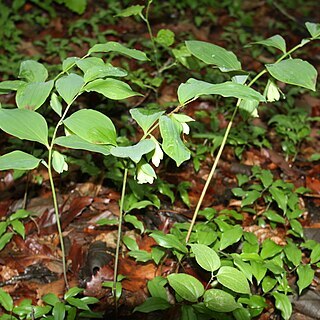Rhizome terete, 3--5 mm thick, slender. Stem arching, 20--50 cm, glabrous. Leaves 4--7, alternate; petiole short or indistinct; leaf blade broadly elliptic to ovate, usually 5--10 × 3--6 cm, glabrous, base rounded or tapering, apex acute to shortly acuminate. Inflorescences 2-flowered; peduncle 1--2 cm, glabrous; bracts 2, borne at base of pedicel, ovate to broadly ovate-elliptic, 2--3.5 × 1--3 cm, leaflike, 7-or more veined, persistent. Flowers pendulous; pedicel 1--2 mm, glabrous. Perianth greenish white, cylindric, 2.3--2.5 cm; lobes ca. 3 × 2 mm. Filaments ± compressed, 2--4 mm, papillose; anthers 3--5 mm. Ovary ca. 5 mm. Style 1.8--2 cm, slightly exserted. Berries ca. 1 cm in diam., 7-or 8-seeded. Fl. May--Jun, fr. Aug--Sep. 2 n = 18*, (20, 22).
More
A herb. It has rhizomes or underground stems. These are 3-5 mm thick. The stem arches over. It is 20-50 cm high. There are 4-7 leaves which are alternate. The leaf stalk is short. The leaf blade is broadly oval and 5-10 cm long by 3-6 cm wide. The base is rounded. The flowering stalks has 2 flowers. The flowers hang downwards. The fruit is a berry. It is about 1 cm across and has 7 or 8 seeds.
The rhizomes are cleaned, parboiled, drained and partially dried and rubbed between the hands. It is the sliced and cooked with other foods. The sprouts are also eaten raw in salads or pickled. They are also fried or blanched and added to soups.

